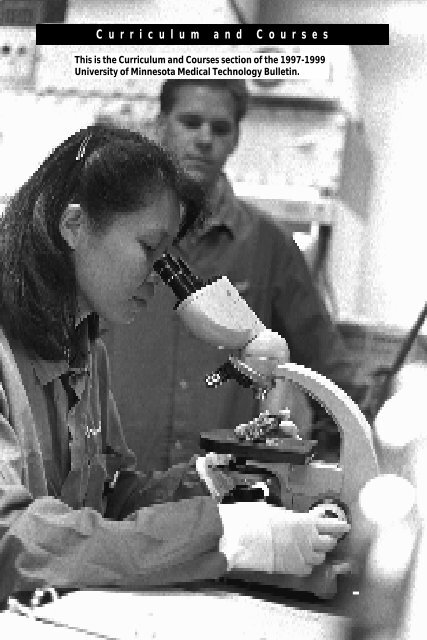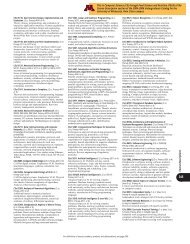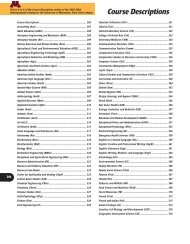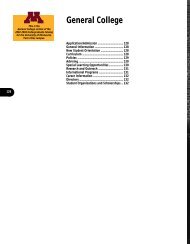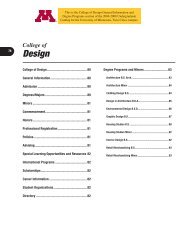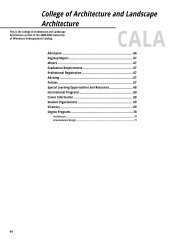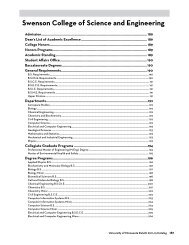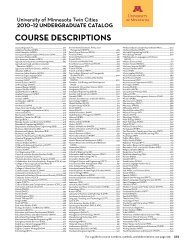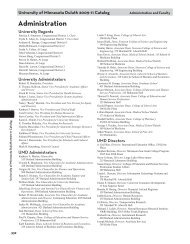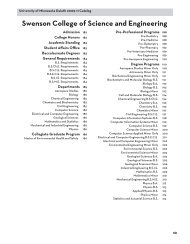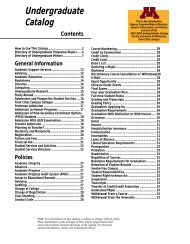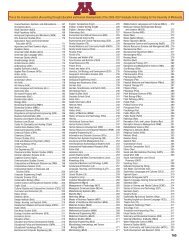C u r r i c u l u m a n d C o u r s e s - University Catalogs
C u r r i c u l u m a n d C o u r s e s - University Catalogs
C u r r i c u l u m a n d C o u r s e s - University Catalogs
- No tags were found...
Create successful ePaper yourself
Turn your PDF publications into a flip-book with our unique Google optimized e-Paper software.
Curricular RequirementsBachelor of Science ProgramTo help students achieve a liberal education, theDivision of Medical Technology expects eachstudent to distribute some part of his or hercoursework in areas of study outside the major.To integrate the goals of both a liberal andprofessional education in a manner appropriate toa baccalaureate curriculum in medical technology,the program emphasizes vigorous training in thebiological and physical sciences, with specialemphasis on acquiring a knowledge of biologyand chemistry that is basic to all facets oflaboratory science. The program includes not onlyscientific information and technical skills but alsothe development of professional and caringattitudes and a commitment to lifelong learning.In addition to prerequisite courses, liberaleducation courses are required. They do not haveto be completed during the preprofessionalyears. Consult the Class Schedule for a completelisting of courses commonly used to meet liberaleducation requirements.Students applying to the Division of MedicalTechnology who will be earning their secondbaccalaureate degree are not required to meet<strong>University</strong> of Minnesota liberal educationrequirements.Diversified Core• Physical and biological sciences, 12-cr minimum, must include onelaboratory course.• History and social science, three courses, 12-cr minimum.One course must be in a historical perspective category.• Arts and humanities, three courses, 12-cr minimum.• Mathematical thinking, one course, 4-cr minimum.Designated ThemesSix courses from the following:cultural diversityinternational relationsWriting SkillsSee page 16.citizenship and public ethicsenvironmentPreprofessional Program—Students register inthe College of Liberal Arts (CLA) or anothercomparable college for the preprofessionalprogram. The following courses or theirequivalents must be completed before admissionto the professional program. (Quarter credits areindicated in parentheses.)CBN 3001—Elementary Anatomy (4)and CBN 3005—Anatomy Laboratory (1)Biol 1009—General Biology (5)Chem 1051-1052—General Principles of Inorganic Chemistry (8)Chem 3301-3302—Organic Chemistry (8) (lecture)Chem 3305-3306—Organic Chemistry Laboratory (4)Completion of the freshman composition requirement as defined by CLA.HSU 5210—Terminology of the Health Sciences (2)strongly recommended.Math 1031 or Math 1051 or Math 1251—College Algebraor Precalculus or Calculus (4) or Stat 3011—StatisticalAnalysis (8) (two courses from these four)MedT 1010—Orientation in Medical Technology (1)(optional, but recommended)Phys 1041-1042—Introductory Physics (10)Electives satisfying liberal education requirements to total 90 credits.Other courses that are equivalent or morecomprehensive may be substituted for the requiredcourses. Students planning to pursue graduateprograms or medical school should take threequarters of calculus and a higher-level physics.Students should also complete the freshmancomposition requirement in their first year.Students who transfer into the preprofessionalprogram are exempted from the MedT 1010course. The credit earned in this course does notcount toward a B.S. degree.The following program schedule is suggested for the preprofessional years (credits in parentheses):Fall Winter SpringFIRST YEAR Gen Chem 1051 (4) Engl Comp 1011 (5) Biol 1009 (5)Core elective Gen Chem 1052 (4) Core electiveMath 1031 or 1051 or 1251 Core elective Core electiveMedT 1010 (1) Elective ElectiverecommendedSECOND YEAR Chem 3301 (4) Chem 3302 (4) CBN 3001/3003 (5) (Anat)Chem 3305 (2) Chem 3306 (2) Stat 3011 (4)HSU 5210 (2) Phys 1042 (5) Core electivePhys 1041 (5)Core/theme electivesNote: To complete the prerequisites in two years, elective courses must satisfy both a diversified core and a designated theme.17
CURRICULUM AND COURSESProfessional Program—Students register in theDivision of Medical Technology for theprofessional program. The following courses mustbe completed to satisfy requirements for graduation.(Quarter credits are indicated in parentheses.)Biol 5003—Genetics (4)MdBc 5300, 5301—Biochemistry (7)MedT 5010—Introduction to Clinical Laboratory Science (2)MedT 5064, 5065—Introduction to Clinical Immunohematology (5)(lecture and laboratory)MedT 5077, 5078—Hematology, Hemostasis/Instrumentation (6)MedT 5080—Seminar: Specialty Rotations (1)MedT 5082—Applied Clinical Chemistry (4)MedT 5084—Applied Clinical Virology (1)MedT 5085—Applied Clinical Hematology (4)MedT 5086—Applied Clinical Immunohematology (4)MedT 5088—Applied Diagnostic Microbiology (4)MedT 5089—Specialty Rotation (1)MedT 5100—Virology/Mycology/Parasitology (3) (lecture)MedT 5102—Principles of Diagnostic Microbiology (5)MedT 5127—Introduction to Management and Education (1)MedT 5310—Clinical Chemistry I (2)MedT 5311—Clinical Chemistry I—Laboratory Applications (2)MedT 5320—Clinical Chemistry II (2)MedT 5321—Clinical Chemistry II—Laboratory Applications (2)MedT 5330—Clinical Chemistry III (2)MedT 5331—Clinical Chemistry III—Laboratory Applications (2)MedT 5765—Hematology Morphology (4)Phsl 3051—Human Physiology (5)VPB 3103—General Microbiology (5)ElectivesLaMP 5177—Pathology (4) strongly recommendedMicB 5218—Immunology (3) recommendedMedT 5090—Special Laboratory Methods (1-2)MedT 5092—Honors Program in Laboratory Methods (5)Other courses in communications, economics,business, and computer science are recommendedbut not required.The clinical courses (MedT 5082, 5084, 5085,5086, 5088, and 5089) consist of applying basicmethods and techniques in chemistry, virology,hematology, immunohematology, microbiology,and a specialty in the clinical laboratories of theFairview-<strong>University</strong> Medical Center and otheraffiliated institutions. These clinical courses areusually offered fall and winter quarters and on aspace-available basis during summer terms.Assignment to these courses is made on anindividual basis; GPA is a criterion.A minimum grade of C is required in eachintroductory course in order to enroll in eachrelated clinical course. The introductory andrelated clinical courses are:Introductory CoursesRelated Clinical CoursesMedT 5064, 5065 MedT 5086MedT 5077, 5078, 5765 MedT 5085MedT 5310, 5311, 5320, MedT 50825321, 5330, 5331MedT 5100, 5102 MedT 5084, 5088Registration in <strong>University</strong> College coursesconcurrently with clinical courses requires theconsent of the Division of Medical Technology’sStudent Concerns Committee. A maximum of fivequarter/semester credits may be taken in <strong>University</strong>College concurrently with the clinical courses.The following program schedule is suggested for the professional years (credits in parentheses):Fall Winter Spring Summer SessionTHIRD Biochem 5300 (4) Biochem 5301 (3) LaMP 5177 (4) No coursesYEAR Comp 3033 (4) Biol 5003 (4) VPB 3103 (5) (Micro)Phsl 3051 (5) Theme elective Theme electiveFOURTH MedT 5010 (2) MedT 5127 (1) MedT 5064/5065 (5) ClinicalYEAR MedT 5077 (3) MedT 5078 (3) MedT 5765 (4) rotations (8-9)MedT 5102 (5) MedT 5100 (3) MedT 5330 (2) (if available)MedT 5310 (2) MedT 5080 (1) MedT 5331 (2)MedT 5311 (2) MedT 5320 (2)MedT 5321 (2)FIFTH Clinical Clinical rotations (8-9) Clinical rotationsYEAR rotations (8-9) (Two quarters/18 credits of (only if needed)clinical courses are required)18
Master of Science ProgramGraduate work in clinical laboratory science isavailable for qualified candidates who wish toprepare for a career of research, teaching, orwork in industry. The master of science degreeprogram in clinical laboratory science is offeredby the Graduate School. The program is offeredonly under the Graduate School Plan A(master’s degree with thesis). Each studentmust complete a thesis involving independentresearch in one of the subareas of this fieldunder the direction of an adviser.Using theCourse DescriptionsThe course descriptions in this bulletin are primarily for coursesoffered by the Division of Medical Technology and taught bymembers of the program faculty or cooperating faculty from othereducational units of the <strong>University</strong>. Meeting hours, days, androoms for these courses are listed in the quarterly Class Schedule.For complete listings and descriptions of courses taught byother educational units of the <strong>University</strong>, see the bulletins of thoseunits.Course Numbers and Symbols—Courses primarily for freshmenand sophomores are numbered 1000 through 1998; for juniors andseniors, 3000 through 3998; for juniors, seniors, and graduatestudents, 5000 through 5998. Courses numbered 8000 and aboveare open only to graduate students. The following symbols areused throughout the descriptions:, ............. The comma, used in prerequisite listings, means “and.”† ............ All courses preceding this symbol must be completedbefore credit will be granted for any quarter of thesequence.§ ............ Credit will not be granted if credit has been received forthe course listed after this symbol. ............ Concurrent registration is required (or allowed) in thecourse listed after this symbol.# ............ Approval of the instructor is required for registration.∆ ........... Approval of the department offering the course isrequired for registration.❏ ........... Approval of the college offering the course is required forregistration.A prerequisite course listed by number only (e.g., prereq 5246) isin the same department as the course being described.A hyphen between course numbers (e.g., 3142-3143-3144)indicates a sequence of courses that must be taken in the orderlisted.A comma between course numbers (e.g., 1234, 1235, 1236)indicates a series of courses that may be entered any quarter.Admission requirements include abachelor’s degree from an accredited institutionof higher learning with sufficient scholarlyattainment in medical technology or chemistryand the biological sciences to justify graduatework in these areas.More information about the program isavailable in the Graduate School Bulletin. Fordetailed information, contact Claire Bjorklund,Graduate Programs Coordinator, Box 609Mayo, 420 Delaware Street S.E., Minneapolis,MN 55455 (612/625-8952).Medical Technology Courses(MedT)MedT 1010. Orientation in Medical Technology.(1 cr [no cr toward degree])Orientation to the medical technology (clinical laboratoryscience) profession.MedT 5010. Introduction to Clinical LaboratoryScience. (2 cr; prereq regis professional MedT program)Basic lab techniques. Centrifuges, analytical balances,photometry. Microscopy and pipetting. Calculations and qualitycontrol. Blood collection and specimen handling. Safety.MedT 5064. Introduction to ClinicalImmunohematology. (3 cr)Lecture. Principles of blood grouping, antibody identification,compatibility testing, immunology, and serology.MedT 5065. Introduction to ClinicalImmunohematology. (2 cr)Lab exercises illustrating basic techniques used in bloodbanking and immunology.MedT 5077. Hematology I: Basic Techniques. (3 cr)Theory and application of basic principles and techniques inclinical hematology. Lecture and lab.MedT 5078. Hematology II: Hemostasis/Instrumentation. (3 cr; prereq 5077)Theory and application of basic principles and techniques inhemostasis and hematology instrumentation. Lecture and lab.MedT 5080. Seminar: Specialty Rotations. (1 cr;prereq regis professional MedT program)Presentations describing each lab offering specialty rotations.For seniors planning their clinical rotation programs.MedT 5082. Applied Clinical Chemistry. (4 cr;prereq 5310, 5311, 5320, 5321, 5330, 5331)Application of basic methods and techniques in clinicalchemistry in the lab.MedT 5084. Applied Clinical Virology. (1 cr;prereq 5064, 5065, 5100, 5102)Application of basic methods and techniques in the virology lab.MedT 5085. Applied Clinical Hematology. (4 cr;prereq 5077, 5078, 5765)Application of methods and techniques in clinicalhematology, morphology, and hemostasis.19
CURRICULUM AND COURSESMedT 5086. Applied ClinicalImmunohematology. (4 cr; prereq 5064, 5065)Application of basic techniques and methods in bloodbanking and immunology in the clinical laboratory. Bloodgrouping, compatibility testing, and immunologic procedures.MedT 5088. Applied Diagnostic Microbiology.(4 cr; prereq 5100, 5102)Identification of bacteria by biochemical and microscopictechniques. Assays for microbial antibiotic susceptibility.Identification of parasites and fungi.MedT 5089. Specialty Rotation. (1 cr; prereqcompletion of MedT preclinical professional courses)One-week clinical rotation in a specialty lab such asimmunophenotyping, cytogenetics, surgical pathology,molecular diagnostics, advanced virology, or advancedcoagulation.MedT 5090. Special Laboratory Methods. (1-2 cr)Assignment on an individual basis to one of a wide varietyof special areas of experience in the clinical laboratory.MedT 5092. Honors Program in LaboratoryMethods. (5 cr)Individual assignment to special projects or research with moreintensive treatment in one of the clinical areas of chemistry,hematology, immunohematology, or microbiology.MedT 5100. Virology/Mycology/Parasitology forMedical Technologists. (3 cr; prereq VPB 3103 or equiv)Basic aspects of lab diagnosis of viral, fungal, and parasiticinfections. Lecture.MedT 5102. Principles of DiagnosticMicrobiology. (5 cr; prereq VPB 3103)Current techniques used in the laboratory diagnosis ofinfectious disease; isolation and identification of bacteria andyeasts; antimicrobial susceptibility testing. Lecture and lab.MedT 5127. Introduction to Management andEducation. (1 cr)Basic concepts in management and education.MedT 5310. Clinical Chemistry I. (2 cr)Renal structure and function and the analysis of urine andbody fluids. Renal role in homeostasis and chemical methodsto evaluate renal function. Quality assurance, quality control,reference ranges, method evaluation. Lecture.MedT 5311. Clinical Chemistry I—LaboratoryApplications. (2 cr)Basic lab techniques for analyzing urine and body fluids(physical, chemical, microscopic). Lab skills developedinclude performing renal function tests (e.g., creatinine,urea) and using instrumentation (e.g., spectrophotometers).MedT 5320. Clinical Chemistry II. (2 cr)Electrolytes, acid-base balance, endocrinology, proteins, andcarbohydrates. Emphasis on measurement methods andphysiological relevance. Lecture.MedT 5321. Clinical Chemistry II—LaboratoryApplications. (2 cr)Analyzing electrolytes, osmolality, blood gases, hormones,and proteins. Development of lab skills and instrumentationuse with emphasis on quality control and technique.Methods include nephelometry, electrophoresis,immunoassays, and colorimetric techniques.MedT 5330. Clinical Chemistry III. (2 cr)Lipids, therapeutic drug monitoring, toxicology, enzymes,liver, and digestive tract. Emphasis on measurementmethods and physiological relevance. Lecture.MedT 5331. Clinical Chemistry III—LaboratoryApplications. (2 cr)Analyzing lipids, drugs, enzymes, liver, and digestivefunction tests. Techniques include electrophoresis; affinity,thin-layer, and gas chromatography; immunoassays; andspectrophotometric techniques.MedT 5765. Hematology Morphology. (4 cr)Morphology, development, and function of hematopoieticcells, with emphasis on examining peripheral blood andbone marrow. Correlation of hematology morphologicfindings with specific physiologic or pathologic processes.Required CoursesOffered by Other UnitsCBN 3001/3003. Elementary Anatomy. (5 cr;prereq regis paramed fields, 1 qtr college biology)A general survey of human anatomy including histology,embryology, gross anatomy, and neuroanatomy, with someclinical and physiological correlations.Biol 1009. General Biology. (5 cr)Introduction to the principles of biology. The cell,metabolism, heredity, reproduction, ecology, and evolution.Biol 5003. Genetics. (4 cr, §GCB 3022, §GCB 5022;prereq 5001 or BioC 3021 or BioC 5331)Introduction to the nature of genetic information and itstransmission from parents to offspring, expression in cellsand organisms, and course in populations.Chem 1051-1052. Chemical Principles I-II. (4 crper qtr; primarily for science or engineering majors;prereq 1001 or passing placement examination; 3 lect,1 lab discussion, one 3-hr lab per wk)Atomic theory; periodic properties of elements; chemicalthermodynamics; development of structural concepts;geometry of molecules; bonding theory; behavior of gaseousand liquid states; solid state and materials; chemistry;dynamics; equilibrium; behavior of solutions; acids andbases; descriptive chemistry of elements and compounds.Chem 3301-3302. Elementary Organic ChemistryI-II. (4 cr per qtr; prereq 1052 or equiv)Important classes of organic compounds, their constitutions,configurations, and conformations; relationship betweenmolecular structure and chemical reactivity. Reactions oforganic compounds, nucleophilic substitution and addition;electrophilic substitution and addition; elimination reactions;molecular arrangements; oxidation and reduction.Chem 3305. Elementary Organic ChemistryLaboratory I. (2 cr; prereq 3301 or 3301)Lab techniques used in preparing, purifying, andcharacterizing typical organic substances.Chem 3306. Elementary Organic ChemistryLaboratory II. (2 cr; prereq 3302 or 3302)Continuation of Chem 3305.LaMP 5177. Pathology for Allied Health Students.(4 cr)General and systems pathology. Strongly recommended.20
Math 1031. College Algebra and Probability.(4 cr, §1051, §1111, §1151, §1201; prereq 3 yrs highschool math, placement exam or GC 0631 with a gradeof C or better)Algebra and analytic geometry explored in greater depth than isusually done in three years of high school mathematics. Additionaltopics from combinations, permutations, and probability. Asuitable prerequisite for 1131 or 1142, but not for 1251.Math 1051. Precalculus I. (4 cr, §1008, §1031, §1111,§1151, §1201; prereq 3 yrs high school mathematics,placement exam or GC 0631 with a grade of C or better)Algebra, analytic geometry, and trigonometry beyond theusual coverage found in a three-year high schoolmathematics program. First of two courses (see 1151).Prepares students for the full calculus sequence. Not anacceptable prerequisite for 1131.Math 1251-1252. One-Variable Differential andIntegral Calculus I-II. (4 cr each, §1211-1221, §1411H-1421H, §1451H-1452H; prereq 4 yrs high schoolmathematics including trigonometry or grade of C orbetter in 1151 or equiv; grade of C or better in 1251required for 1252)Calculus of functions of one-variable and related geometryand applications.MdBc 5300. Biochemistry. (4 cr; prereq organicchemistry, physics)Biochemical principles. Includes proteins, enzymes,biological energy metabolism, glycolysis, citric acid cycle,pentose phosphate pathway, gluconeogenesis, glycogenmetabolism, fatty acid metabolism, amino acid metabolism,biological membranes. DNA, RNA, the genetic code,control of gene expression.MdBc 5301. Biochemistry. (3 cr; prereq BioC 3021or MdBc 5300)Biochemical principles. Includes protein synthesis, bodyfluids, hemoglobin, respiration, kidney function, acid basebalance, endocrinology, nutrition, and vitamins.Phsl 3051. Human Physiology. (5 cr)The study of normal function (processes) in humans.Phys 1041-1042. Introductory Physics. (5 cr perqtr; prereq high school algebra and plane geometry;4 lect, 1 rec, 2 lab hrs per wk)Lectures, recitation, and lab sessions. Primarily for studentsinterested in topics useful in technical areas. Fundamentalprinciples of physics in context of the everyday world. Useof kinematics, dynamics, and conservation principles withquantitative and qualitative problem-solving techniques tounderstand phenomena of mechanics, electromagnetism, andthe structure of matter.Stat 3011. Statistical Analysis. (4 cr per qtr; prereqcollege algebra)Descriptive statistics; elementary probability; estimation; oneandtwo-sample tests; correlation; introduction to regression;ANOVA; randomized blocks; multiple comparisons; factorialexperiments; multiple regression; goodness of fit;nonparametric methods; contingency tables; selected topics.VPB 3103. General Microbiology. (5 cr)Basic techniques in microbiology, including microscopy,culture techniques, and microbial structure and growth;application of microbiological techniques to a wide varietyof disciplines, including food microbiology, environmentalmicrobiology, and infectious disease. Lecture and lab.Graduate Courses in MedicalTechnology (MedT) orClinical Laboratory Science (CLS)CLS 5120. Seminar: Medical Technology. (1-3 cr)CLS 5125. Practicum: Teaching. (max 3 cr)CLS 5128. Elements of Laboratory Administration.(3 cr)CLS 5130. Practicum in Laboratory Administration.(3 cr)CLS 5133. Medical Mycology. (4 cr)CLS 5135. Advanced Clinical Microbiology. (5 cr)CLS 5140. Techniques for Teaching. (3 cr)CLS 5145. Development of Medical Technology.(3 cr)CLS 5155. Advanced Clinical Hematology. (5 cr)CLS 5165. Advanced ClinicalImmunohematology. (5 cr)CLS 5173. Analytic Techniques in LaboratoryMedicine.CLS 5175. Advanced Clinical Chemistry. (5 cr)CLS 5179. Chemistry Seminar. (1 cr)CLS 8176. Advanced Topics in Clinical Chemistry.(Cr ar)CLS 8230. Advanced Medical Bacteriology. (Cr ar)21


